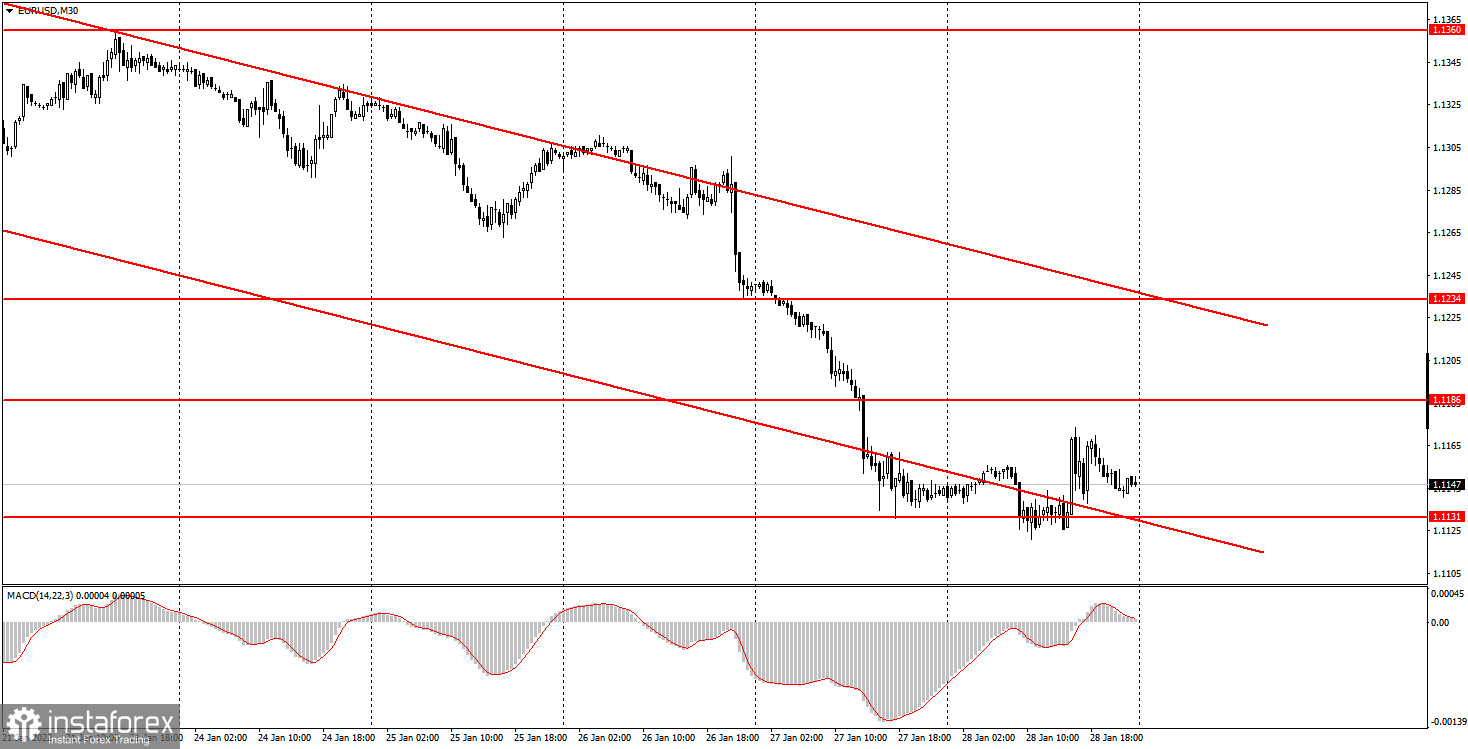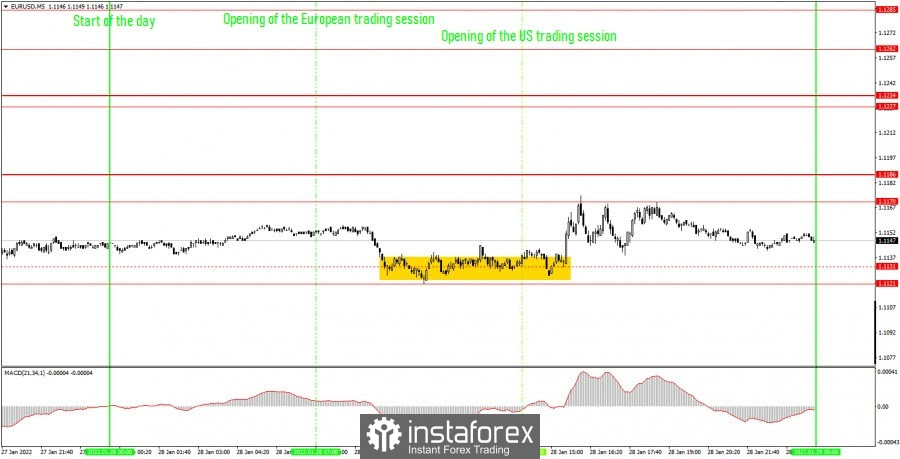Analysis of previous deals:
30M chart of the EUR/USD pair

The EUR/USD pair tried to overcome the 1.1131 level several times on the 30-minute timeframe on Friday, but it failed to do so. . As a result, there was a rebound from this level, but the upward correction, as such, did not begin. The pair managed to move away by only 50 points from the low of the day, which also indicates low volatility on Friday. In principle, after the super-saturated Wednesday and Thursday, the market needed a little rest. The only thing is that we still expected to see an upward correction. However, the euro/dollar pair continues to remain inside the descending channel, that is, the downward movement may resume at any moment. But at the same time, the pair has a growth potential, since it is currently near the lower border of the channel and can adjust to the upper one. There were few macroeconomic reports on Friday. We see in the chart above that the main movement happened on the candle at 13-30 GMT, that is, exactly at the time when reports were published in America. Judging by the fact that the dollar was actively getting cheaper at that time, traders did not like the statistics, but there were no blatant disappointing reports. The main index of personal consumption expenditures came out in exact accordance with the forecast, as well as the level of spending of the US population. Only the income level was slightly lower. Therefore, the market reaction is actually quite strange.
5M chart of the EUR/USD pair

On a 5-minute timeframe, the movement on Friday looks quite strange and certainly quite inconvenient for working out. The pair showed good movement only twice during the day, which ended very quickly. There was only one trading signal - near the level of 1.1131, which at the end of the day became irrelevant, and the level of 1.1121 was formed instead. The signal was formed for about six hours, so you can't exactly call it strong and accurate. Novice traders could try to work it out and could earn at most 20 points on it. But, rather, the long position simply closed at a Stop Loss at breakeven, as the price "danced" well from side to side during the US trading session. The level of 1.1170 is a new level - this Friday's high, it did not participate in the trade.
How to trade on Monday:
The downward trend continues on the 30-minute timeframe. However, since the level of 1.1131 has not been crossed, and the price is near the lower border of the descending channel, we expect the pair to correct to the upper part of the descending channel on Monday and Tuesday. It is recommended to trade at the levels of 1.1121, 1.1170-1.1186, 1.1227-1.1234, 1.1262 on the 5-minute TF on Monday. There are no other levels below the level of 1.1121, so it will be more difficult to trade there. But the pair must first go below the level of 1.1121 for this. Macroeconomic background will be absent on Monday. Neither America nor the European Union has any important publications planned. Thus, the euro/dollar gets another good opportunity to correct against last week's fall.
Basic rules of the trading system:
1) The signal strength is calculated by the time it took to form the signal (bounce or overcome the level). The less time it took, the stronger the signal.
2) If two or more deals were opened near a certain level based on false signals (which did not trigger Take Profit or the nearest target level), then all subsequent signals from this level should be ignored.
3) In a flat, any pair can form a lot of false signals or not form them at all. But in any case, at the first signs of a flat, it is better to stop trading.
4) Trade deals are opened in the time period between the beginning of the European session and until the middle of the American one, when all deals must be closed manually.
5) On the 30-minute TF, using signals from the MACD indicator, you can trade only if there is good volatility and a trend, which is confirmed by a trend line or a trend channel.
6) If two levels are located too close to each other (from 5 to 15 points), then they should be considered as an area of support or resistance.
On the chart:
Support and Resistance Levels are the Levels that serve as targets when buying or selling the pair. You can place Take Profit near these levels.
Red lines are the channels or trend lines that display the current trend and show in which direction it is better to trade now.
The MACD indicator (14,22,3) consists of a histogram and a signal line. When they cross, this is a signal to enter the market. It is recommended to use this indicator in combination with trend lines (channels and trend lines).
Important speeches and reports (always contained in the news calendar) can greatly influence the movement of a currency pair. Therefore, during their exit, it is recommended to trade as carefully as possible or exit the market in order to avoid a sharp price reversal against the previous movement.
Beginners on Forex should remember that not every single trade has to be profitable. The development of a clear strategy and money management are the key to success in trading over a long period of time.
 English
English 
 Русский
Русский Bahasa Indonesia
Bahasa Indonesia Bahasa Malay
Bahasa Malay ไทย
ไทย Español
Español Deutsch
Deutsch Български
Български Français
Français Tiếng Việt
Tiếng Việt 中文
中文 বাংলা
বাংলা हिन्दी
हिन्दी Čeština
Čeština Українська
Українська Română
Română

